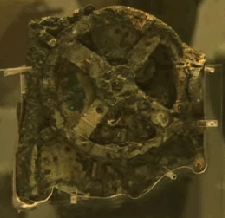|
|
|
|
|
|
|
News & Views item - July 2008 |
![]() A Beautiful Demonstration of True Multidisciplinary Research: The Antikythera
Mechanism
(July 31, 2008)
A Beautiful Demonstration of True Multidisciplinary Research: The Antikythera
Mechanism
(July 31, 2008)
In today's issue of Nature Tony Freeth1,2, Alexander Jones3, John M. Steele4 & Yanis Bitsakis1,5 describe the Antikythera Mechanism, which was recovered from a 2,000-year old shipwreck discovered off the coast of the Greek island, Antikythera in 1900. A celestial analytical engine it demonstrates the engineering pinnacle of the Hellenic world. The new work utilising three-dimensional computerised X-ray tomography reveals "how it could predict eclipses, that it was probably made in a colony of Corinth, possibly even Syracuse — home of Archimedes — and that it had a dial recording the times of the ancient Olympiads".
The introduction to the paper puts it this way:
 Previous
research on the Antikythera Mechanism established a highly complex ancient Greek
geared mechanism with front and back output dials. The upper back dial is a
19-year calendar, based on the Metonic cycle, arranged as a five-turn spiral.
The lower back dial is a Saros eclipse-prediction dial, arranged as a four-turn
spiral of 223 lunar months, with glyphs indicating eclipse predictions. Here we
add surprising findings concerning these back dials. Though no month names on
the Metonic calendar were previously known, we have now identified all 12
months, which are unexpectedly of Corinthian origin. The Corinthian colonies of
northwestern Greece or Syracuse in Sicily are leading contenders—the latter
suggesting a heritage going back to Archimedes. Calendars with excluded days to
regulate month lengths, described in a first century bc source, have hitherto
been dismissed as implausible. We demonstrate their existence in the Antikythera
calendar, and in the process establish why the Metonic dial has five turns. The
upper subsidiary dial is not a 76-year Callippic dial as previously thought,
but follows the four-year cycle of the Olympiad and its associated Panhellenic
Games. Newly identified index letters in each glyph on the Saros dial show that
a previous reconstruction needs modification. We explore models for generating
the unusual glyph distribution, and show how the eclipse times appear to be
contradictory. We explain the four turns of the Saros dial in terms of the full
moon cycle and the Exeligmos dial as indicating a necessary correction to the
predicted eclipse times. The new results on the Metonic calendar, Olympiad dial
and eclipse prediction link the cycles of human institutions with the celestial
cycles embedded in the Mechanism's gearwork.
Previous
research on the Antikythera Mechanism established a highly complex ancient Greek
geared mechanism with front and back output dials. The upper back dial is a
19-year calendar, based on the Metonic cycle, arranged as a five-turn spiral.
The lower back dial is a Saros eclipse-prediction dial, arranged as a four-turn
spiral of 223 lunar months, with glyphs indicating eclipse predictions. Here we
add surprising findings concerning these back dials. Though no month names on
the Metonic calendar were previously known, we have now identified all 12
months, which are unexpectedly of Corinthian origin. The Corinthian colonies of
northwestern Greece or Syracuse in Sicily are leading contenders—the latter
suggesting a heritage going back to Archimedes. Calendars with excluded days to
regulate month lengths, described in a first century bc source, have hitherto
been dismissed as implausible. We demonstrate their existence in the Antikythera
calendar, and in the process establish why the Metonic dial has five turns. The
upper subsidiary dial is not a 76-year Callippic dial as previously thought,
but follows the four-year cycle of the Olympiad and its associated Panhellenic
Games. Newly identified index letters in each glyph on the Saros dial show that
a previous reconstruction needs modification. We explore models for generating
the unusual glyph distribution, and show how the eclipse times appear to be
contradictory. We explain the four turns of the Saros dial in terms of the full
moon cycle and the Exeligmos dial as indicating a necessary correction to the
predicted eclipse times. The new results on the Metonic calendar, Olympiad dial
and eclipse prediction link the cycles of human institutions with the celestial
cycles embedded in the Mechanism's gearwork.
See also: http://www.nytimes.com/2008/07/31/science/31computer.html?em
For subscribers to Nature click here to see the full paper.
And click here for a narrated streaming video describing the Antikythera Mechanism and and showing the different disciplinary expertise used to perform the analyses.
_______________________________________________________
1.Antikythera Mechanism Research Project, 3 Tyrwhitt Crescent, Roath Park,
Cardiff CF23 5QP, UK
2.Images First Ltd, 10 Hereford Road, South Ealing, London W5 4SE, UK
3.Institute for the Study of the Ancient World, 15 East 84th Street, New York,
New York 10028, USA
4. Department of Physics, University of Durham, Rochester Building, South Road,
Durham DH1 3LE, UK
5. Centre for History and Palaeography, 3, P. Skouze str., GR-10560 Athens,
Greece